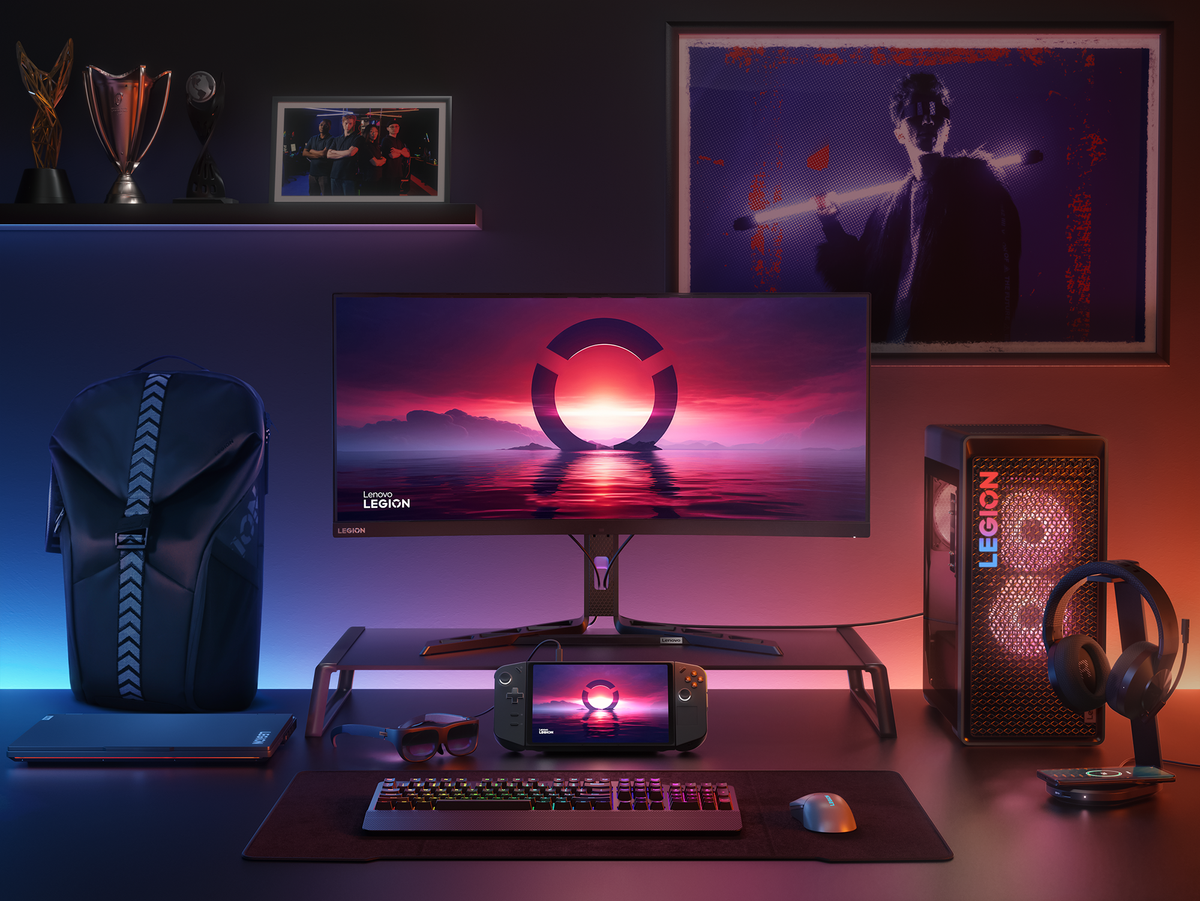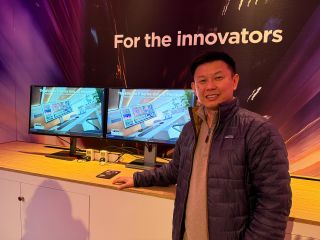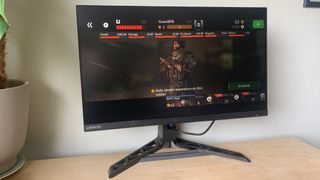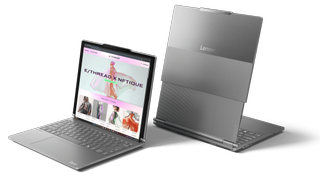I talked to Lenovo's monitor boss about the future of screen tech, and it's big news for creatives
New monitors, future tech and (of course) the spectre of AI.

Monitors are an often-overlooked part of our work and life. For many, it's just that big black rectangle taking up space on your desk, but it actually plays a central role in nearly all creatives' workflow, productivity and perhaps most importantly, the quality of their output. Just as the right monitor can make your life better, so can the wrong one be the bane of your life, which is why we try to help with our continuously updated and strenuously researched guides on the best monitors for graphic artists, photo-editing pros, video creators, and more.
So when I got the opportunity to have a video chat with one of the people in charge of how this central part of our professional existence evolves year-by-year, the VP and GM of Lenovo's Visual Business Unit, George Toh, I jumped at it. What's happening this year in the world of big black mirrors? Where are we headed next? And how will AI affect all of it? Read on to see my in-depth chat with someone so much more knowledgeable about monitor tech than I could ever hope to become. Which is what happens when you have over a quarter of a century's experience in the field, working with giants like HP, Dell, Seagate and now Lenovo...
Monitor launches and variable refresh rate

Erlingur Einarsson: To start off, in your mind, what is the most exciting thing that you're bringing out this year, especially if you think about creatives?
George Toh: So, this year, we launched a series of monitors. [the first] is called the ThinkVision P Series Monitor. It's actually a range. There's quite a lot of models under that umbrella. And then we also had a Legion Pro OLED gaming monitor, and then another Legion gaming monitor.
So that's two gaming products, and then we have a bunch of promotional monitor products, which goes under our ThinkVision branding. These are all designed for promotional-based productivity, and we focus on a few things. One is versatility, we want to make sure the products are easy to use for customers. And then it's got all the needs of the productivity worker.
But this time we are doing a few new things that we think is quite unique. First off, we are enabling variable refresh rate, from 24 hertz all the way up to 120 hertz. If you know monitors, right now in the industry, everyone's trying to push the refresh rate higher and higher. 100 hertz, 120 hertz, and in the gaming space, 240, 360.
Erlingur: Yeah, I saw a 500 hertz monitor out at CES. It's like, that's too many hertz.
Get the Creative Bloq Newsletter
Daily design news, reviews, how-tos and more, as picked by the editors.
George: Like you and me, a lot of times we're reading a static web page or looking at a document and at those kinds of times you really don't need to run at 100 hertz; you can actually go down to 24 hertz and maybe someday even lower. So what does that do, you know? One, you reduce the power the monitor consumes, and two, it reduces the load on the graphics card. The graphics card no longer has to put out, you know, 130 hertz; it can just go down to 24, and then once you start moving the mouse, jump up and down. This helps to save energy without any trade-off for the user.
Panel evolution
George: So, that's one of the things that we do. The other thing that we do is we source an oxide-based panel, an LCD panel. And that's different from the atmospheric silicon panels that I think typical LCDs use. With oxide-based [panels], it lowers the power consumption even more.
And on some of our monitors, we also introduce an AI algorithm in the scalar chip where it analyses the picture coming into the display. And what it does is that it plays with the brightness and the color saturation of the hue.
So, for example, if you drop the brightness down and you raise the saturation, what it does is that the human eye cannot see the hue. So, it can't really tell between, you know, a different image where it's got higher brightness. So we can put in a little bit of that, and overall we've been able to save power on this new generation of product from up to 50% of our energy standard. So for example, the P32 [model], the 31.5[-inch monitor] that we showed at CES, I think the current generation is roughly around 37 to 39 watts; this new generation is about 18.
Erlingur: Oh wow, that's a big energy saving.
George: On the user side, we focus on variable refresh rate, better panels with lower power consumption, and AI algorithms to lower the power consumption rate even more. We also upgraded the experience on the PD charging part, so your monitor can charge up to 96 watts.

3D monitors
Erlingur: And then on the flip side to the energy saving and all of that, you've got the ThinkVision 3D coming out.
George: Yeah, our ThinkVision 3D was something that we announced last year and is already shipping. So right now, the monitor is designed more for kind of a commercial type of usage, things like designers whether they are product designers working on CAD applications, car companies working on some of this modelling stuff, architectural firms. we even found mining companies who are trying to map out the geographical, you know, map of the land and so on. They've been trying this thing out, and also a little bit of education [use].
Erlingur: You're seeing that being picked up by architects and product designers?
George: Yeah, that's right. Also I think gaming as well. We've been trying out different games converted to 3D, also looking at some game publishers and developers.
Creative future
Erlingur: When focusing on those creatives in general, where does the main focus and challenge lie for Lenovo at the moment?
George: We have a product that's designed for creatives. We call it the Creator Extreme. Again, I think the focus is really around how we deliver high colour gamut, how do we deliver a good HDR range and so on. Because I think creators, there are those who are creating still images, photography and all that, and there are those creating videos, and I think the requirements tend to be different. So our product, we focus on having lots of mini-LEDs for dynamic local dimming, and also, I think the right tools and so on. And then we also focus on high colour gamut. 100% sRGB, you know, DCI-P3, and DC709. So, we have that focus.

Is OLED burn-in still a concern?
Erlingur: Lenovo is one of the biggest movers in terms of bringing out OLEDs to monitors, to laptops, to the all-in-ones. One concern that I hear a lot from creatives in particular is the worry about long-term burn-in. So what is your experience with that, now that we have a few years of of OLED experience under our belt?
George: You won't get burn-in within the lifespan of a product, [which is] three years to five years. But we don't think we have any issues, and on top of that, we're also building some algorithm into our OLED products that, based on how long you have worked on the monitor, what's the brightness level, the different type of colour they use, [that] they will dynamically decide when you need to do a maintenance cycle. Yeah, you'll run some patterns and some brush to reset [the panel], and make sure that you don't get... uh, not not really burn-in, like more a shadow image. So we do that and try to improve it further, but I think in general we don't think it's an issue for like a typical lifespan.
Monitor AI to help you work better
Erlingur: For the for the year ahead, where do you think next challenge lies for you, now that you've increased the energy efficiency so much? Where is the next horizon for Lenovo?
George: One thing we will focus on... at our suite at CES, we showed concept products that we are getting very good feedback on. I think we call it the AI Display and what that does is that it has a built-in camera and some other sensors that will capture the person in front of the display and depending on whether you're standing up and sitting down or, you know, a little bit off to the side either way, the monitor will adjust itself. Because I think one of the one of the things that we found is like a lot of users don't really know what's the right way to work with monitors [physically]. Sometimes it's too high, so that you're looking up, and we've been thinking, like, hey, let's get your AI [to help]. Do people really need to be trained? Why can't the monitor be used for them? So we created a group of concepts, [so it will] just magically adjust to, you know, like, the right height, whether you're standing up or sitting down.
Erlingur: That's an exciting aspect of AI for me as well, which is the assistant AI. Which is the AI that can help you do your work better. While we notice, you know, and especially with our readers, who tend to be... Yeah. artists, graphic designers, animators, filmmakers, is that is that there's a lot of apprehension about generative AI. But it's very interesting to see AI used for this, the AI algorithm that controls the variable rate, and the power. And this as well, that proof of concept. But where do you, in terms of visual technology, what do you think are the biggest opportunities and biggest concerns with AI?
George: I think the biggest opportunity is when we talk to our users, the monitor is the central part of their desktop space. They connect some computer device, a notebook, desktop, sometimes a tablet, and then they'll connect their mice and keyboard and sometimes, like hard keys and all that, so it's kind of like a control part. A lot of people like to use big screens and multiple windows, so I think AI uses will gravitate towards larger screens and higher resolutions.
AI today is about software. You've got a lot of software and I think people want to use different AI tools for different purposes. I think AI will also let users create more content. Like, maybe in the past, it takes a long time to generate a 30-second clip [of video content], but in the future you might be able to do like 10 or 15 of them and take the one you like or then mash it up so it'll be much more content.
And with a larger piece of glass, high resolution is going to help with that. I think that's the biggest opportunity for the industry and for all of us. And also, as a display manufacturer, we are trying to look at what sort of sensors make sense to integrate into the monitor. We've seen over the last few years, we've got cameras and mics being integrated so that it can be a VOIP, so that when you do a call like this [the video call we're on], it's easier for users. And I think that's really taken off.
We're also thinking about what else can we integrate, not just the intelligent processing part of AI, but also what our sensors can add in. So I think that's one of the opportunities for us.
Erlingur: And what would you say are the biggest concerns?
George: I think from a monitor industry perspective, I don't see too much concern. I think that there's a general concern everyone has about AI, you know. Like, is this going to take over my job and so on. I'm on the side of, I think it's going to help you do more and just improve productivity. I think it's going to just improve the speed of everything. Speed of development, speed of answering questions.

Thank you for reading 5 articles this month* Join now for unlimited access
Enjoy your first month for just £1 / $1 / €1
*Read 5 free articles per month without a subscription

Join now for unlimited access
Try first month for just £1 / $1 / €1

Erlingur is the Tech Reviews Editor on Creative Bloq. Having worked on magazines devoted to Photoshop, films, history, and science for over 15 years, as well as working on Digital Camera World and Top Ten Reviews in more recent times, Erlingur has developed a passion for finding tech that helps people do their job, whatever it may be. He loves putting things to the test and seeing if they're all hyped up to be, to make sure people are getting what they're promised. Still can't get his wifi-only printer to connect to his computer.
You must confirm your public display name before commenting
Please logout and then login again, you will then be prompted to enter your display name.